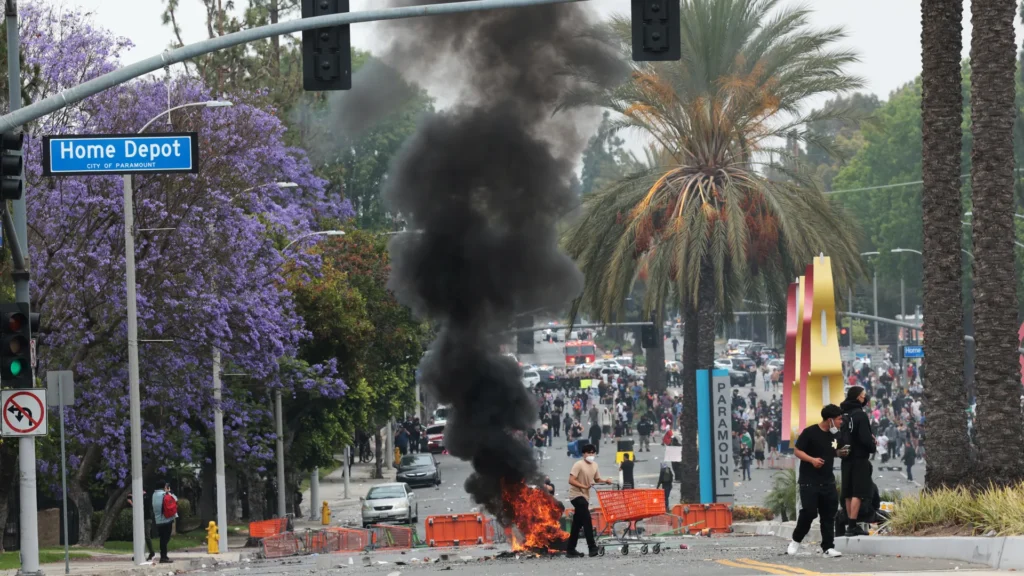U.S. President Donald Trump has sparked nationwide controversy after deploying hundreds of National Guard troops to Los Angeles in response to mass protests over federal immigration raids, marking an aggressive enforcement of his hardline immigration agenda.
The move—made without the consent of California Governor Gavin Newsom—is the first time in 60 years a president has activated a state’s National Guard against the wishes of its governor. The deployment has triggered legal challenges, political backlash, and intensified unrest across major U.S. cities.
Trump’s administration has described the deployment as essential to restoring law and order amid mounting street protests and unrest. “If we didn’t do the job, that place would be burning down,” Trump said Monday, referring to California. “I feel we had no choice.”
Troops on the Ground Amid Mass Arrests
The protests began Friday following reports of immigration raids across Los Angeles, including at a Home Depot and in the fashion district, where dozens of undocumented immigrants were detained. Demonstrations quickly swelled, blocking freeways and leading to confrontations with police, who used tear gas, rubber bullets, and flash-bangs to disperse crowds.
Trump authorized the deployment of up to 4,000 National Guard troops an operation already being bolstered by 700 active-duty U.S. Marines, according to the Defense Department. Despite growing pushback, the president insists the action was necessary due to Governor Newsom’s “incompetence.”
California Pushes Back
California officials have responded with legal action. Attorney General Rob Bonta filed suit against the federal government on Monday, calling the troop deployment an assault on state sovereignty and demanding a restraining order to halt the action.
“This is absolutely a crisis of Trump’s own making,” said Senator Alex Padilla, who criticized the president’s decision to override local control. “The National Guard deployment only escalates tensions it’s exactly what Trump wanted to provoke.”
Newsom’s administration argued the situation was being managed effectively by local law enforcement and denounced the federal action as politically motivated.
A Preview of Trump’s Immigration Crackdown
The dramatic escalation in California appears to be part of Trump’s broader plan to massively ramp up deportations, a campaign promise he touted during his 2024 presidential bid. His aides have signaled intentions to remove up to 1 million undocumented immigrants annually and to expand detention capacity to house up to 100,000 individuals at once.
During the campaign, Trump praised the Eisenhower-era deportation raids and promised to use all tools of executive power including the Insurrection Act to enforce immigration law. His current approach already surpasses his response to the 2020 Black Lives Matter protests, where he had previously claimed governors must first request military assistance.
Nationwide Fallout
The deployment has been met with outrage among civil rights groups, immigrant advocates, and even former Trump allies. Ileana Garcia, founder of Latinas for Trump, denounced the move as “inhumane,” arguing that many of those targeted had legitimate asylum claims or were awaiting immigration hearings.
“This is not law enforcement. This is political theater with real human costs,” Garcia said.
Meanwhile, protests have spread to Chicago, Boston, and New York, with organizers calling for a national day of action. Images of burning vehicles, graffiti, and Mexican flags have flooded social media, further fueling debate about the president’s handling of the crisis.
What’s Next?
As legal challenges move through the courts and Congress debates a Trump-backed tax-and-border package, the situation remains tense. Trump has asked Congress for billions in funding to dramatically expand ICE operations, Border Patrol hiring, and detention centers.
The White House maintains that it is acting within its authority. However, with court rulings pending and public outrage mounting, whether the American public supports such unprecedented use of military force for immigration enforcement remains uncertain.


